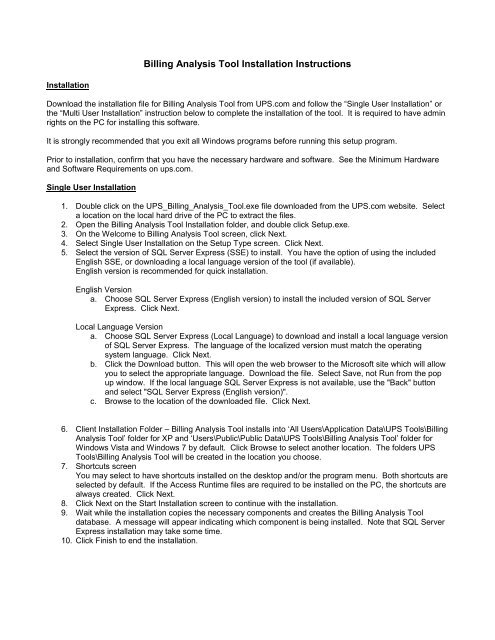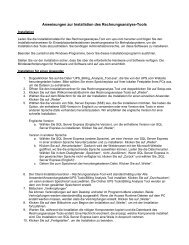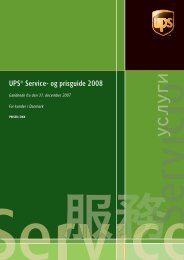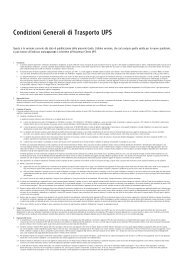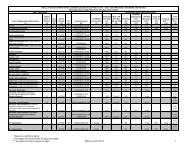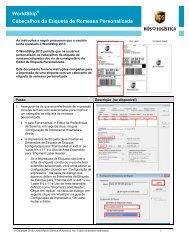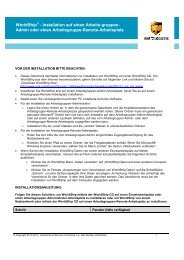Billing Analysis Tool Installation Instructions
Billing Analysis Tool Installation Instructions
Billing Analysis Tool Installation Instructions
Create successful ePaper yourself
Turn your PDF publications into a flip-book with our unique Google optimized e-Paper software.
<strong>Installation</strong><br />
<strong>Billing</strong> <strong>Analysis</strong> <strong>Tool</strong> <strong>Installation</strong> <strong>Instructions</strong><br />
Download the installation file for <strong>Billing</strong> <strong>Analysis</strong> <strong>Tool</strong> from UPS.com and follow the “Single User <strong>Installation</strong>” or<br />
the “Multi User <strong>Installation</strong>” instruction below to complete the installation of the tool. It is required to have admin<br />
rights on the PC for installing this software.<br />
It is strongly recommended that you exit all Windows programs before running this setup program.<br />
Prior to installation, confirm that you have the necessary hardware and software. See the Minimum Hardware<br />
and Software Requirements on ups.com.<br />
Single User <strong>Installation</strong><br />
1. Double click on the UPS_<strong>Billing</strong>_<strong>Analysis</strong>_<strong>Tool</strong>.exe file downloaded from the UPS.com website. Select<br />
a location on the local hard drive of the PC to extract the files.<br />
2. Open the <strong>Billing</strong> <strong>Analysis</strong> <strong>Tool</strong> <strong>Installation</strong> folder, and double click Setup.exe.<br />
3. On the Welcome to <strong>Billing</strong> <strong>Analysis</strong> <strong>Tool</strong> screen, click Next.<br />
4. Select Single User <strong>Installation</strong> on the Setup Type screen. Click Next.<br />
5. Select the version of SQL Server Express (SSE) to install. You have the option of using the included<br />
English SSE, or downloading a local language version of the tool (if available).<br />
English version is recommended for quick installation.<br />
English Version<br />
a. Choose SQL Server Express (English version) to install the included version of SQL Server<br />
Express. Click Next.<br />
Local Language Version<br />
a. Choose SQL Server Express (Local Language) to download and install a local language version<br />
of SQL Server Express. The language of the localized version must match the operating<br />
system language. Click Next.<br />
b. Click the Download button. This will open the web browser to the Microsoft site which will allow<br />
you to select the appropriate language. Download the file. Select Save, not Run from the pop<br />
up window. If the local language SQL Server Express is not available, use the "Back" button<br />
and select "SQL Server Express (English version)".<br />
c. Browse to the location of the downloaded file. Click Next.<br />
6. Client <strong>Installation</strong> Folder – <strong>Billing</strong> <strong>Analysis</strong> <strong>Tool</strong> installs into ‘All Users\Application Data\UPS <strong>Tool</strong>s\<strong>Billing</strong><br />
<strong>Analysis</strong> <strong>Tool</strong>’ folder for XP and ‘Users\Public\Public Data\UPS <strong>Tool</strong>s\<strong>Billing</strong> <strong>Analysis</strong> <strong>Tool</strong>’ folder for<br />
Windows Vista and Windows 7 by default. Click Browse to select another location. The folders UPS<br />
<strong>Tool</strong>s\<strong>Billing</strong> <strong>Analysis</strong> <strong>Tool</strong> will be created in the location you choose.<br />
7. Shortcuts screen<br />
You may select to have shortcuts installed on the desktop and/or the program menu. Both shortcuts are<br />
selected by default. If the Access Runtime files are required to be installed on the PC, the shortcuts are<br />
always created. Click Next.<br />
8. Click Next on the Start <strong>Installation</strong> screen to continue with the installation.<br />
9. Wait while the installation copies the necessary components and creates the <strong>Billing</strong> <strong>Analysis</strong> <strong>Tool</strong><br />
database. A message will appear indicating which component is being installed. Note that SQL Server<br />
Express installation may take some time.<br />
10. Click Finish to end the installation.
Multi User <strong>Installation</strong><br />
If multiple users want to access the same billing data this will require installation of the SQL Server Express<br />
database first on the shared computer, followed by installation of the Client on each PC that wishes to access<br />
the data.<br />
Shared Database PC:<br />
1. Double click on the UPS_<strong>Billing</strong>_<strong>Analysis</strong>_<strong>Tool</strong>.exe file downloaded from the UPS.com website. Select<br />
a location to extract the files.<br />
2. Open the <strong>Billing</strong> <strong>Analysis</strong> <strong>Tool</strong> <strong>Installation</strong> folder, and double click Setup.exe.<br />
3. On the Welcome to <strong>Billing</strong> <strong>Analysis</strong> <strong>Tool</strong> screen, click Next.<br />
4. Select Multiple User <strong>Installation</strong> on the Setup Type screen. Click Next.<br />
5. Select SQL Server Component on the Multiple User <strong>Installation</strong> Options screen. Click Next.<br />
6. Select the version of SQL Server Express (SSE) to install. You have the option of using the included<br />
English SSE, or downloading a local language version of the tool (if available). English version is<br />
recommended for quick installation.<br />
English Version<br />
a. Choose SQL Server Express (English version) to install the included version of SQL Server<br />
Express. Click Next.<br />
Local Language Version<br />
a. Choose SQL Server Express (Local Language) to download and install a local language version<br />
of SQL Server Express. The language of the localized version must match the operating<br />
system language. Click Next.<br />
b. Click the Download button. This will open the web browser to the Microsoft site which will allow<br />
you to select the appropriate language. Download the file. Select Save, not Run from the pop<br />
up window. If the local language SQL Server Express is not available, use the "Back" button<br />
and select "SQL Server Express (English version)".<br />
c. Browse to the location of the downloaded file. Click Next.<br />
7. Server <strong>Installation</strong> Folder – By default, SQL Server Express will install into \Program<br />
Files\Microsoft SQL Server. Click Browse to select another location. The folder \Microsoft SQL Server<br />
will be created in the location you choose.<br />
8. Click Next on the Start <strong>Installation</strong> screen to continue with the installation.<br />
9. Wait while the installation copies the necessary components and creates the <strong>Billing</strong> <strong>Analysis</strong> <strong>Tool</strong><br />
database. A message will appear indicating which component is being installed. Note that SQL Server<br />
Express installation may take some time.<br />
10. Click Finish to end the installation.<br />
Client PC(s):<br />
1. Double click on the UPS_<strong>Billing</strong>_<strong>Analysis</strong>_<strong>Tool</strong>.exe file downloaded from the UPS.com website. Select<br />
a location to extract the files.<br />
2. Open the <strong>Billing</strong> <strong>Analysis</strong> <strong>Tool</strong> <strong>Installation</strong> folder, and double click Setup.exe.<br />
3. On the Welcome to <strong>Billing</strong> <strong>Analysis</strong> <strong>Tool</strong> screen, click Next.<br />
4. Select Multiple User <strong>Installation</strong> on the Setup Type screen. Click Next.<br />
5. Select <strong>Billing</strong> <strong>Analysis</strong> <strong>Tool</strong> Client on the Multiple User <strong>Installation</strong> Options screen. Click Next.<br />
6. Client <strong>Installation</strong> Folder – <strong>Billing</strong> <strong>Analysis</strong> <strong>Tool</strong> installs into ‘All Users\Application Data\UPS <strong>Tool</strong>s\<strong>Billing</strong><br />
<strong>Analysis</strong> <strong>Tool</strong>’ folder for XP and ‘Users\Public\Public Data\UPS <strong>Tool</strong>s\<strong>Billing</strong> <strong>Analysis</strong> <strong>Tool</strong>’ folder for<br />
Windows Vista and Windows 7. Click Browse to select another location. The folders UPS <strong>Tool</strong>s\<strong>Billing</strong><br />
<strong>Analysis</strong> <strong>Tool</strong> will be created in the location you choose.
7. On the SQL Server Connection screen, enter the name of the shared server machine name that was<br />
installed during Shared Database setup. This should be in the format \UPSBAT.<br />
UPSBAT is the name of the SQL Server Express instance that was installed.<br />
8. Shortcuts screen<br />
You may select to have shortcuts installed on the desktop and/or the program menu. Both shortcuts are<br />
selected by default. If the Access Runtime files are required to be installed on the PC, the shortcuts are<br />
always created. Click Next.<br />
9. Click Next on the Start <strong>Installation</strong> screen to continue with the installation.<br />
10. Wait while the installation copies the necessary components. A message will appear indicating which<br />
component is being installed.<br />
11. Click Finish to end the installation.<br />
Using <strong>Billing</strong> <strong>Analysis</strong> <strong>Tool</strong> with an existing SQL Server 2000 or SQL Server 2005 installation<br />
<strong>Billing</strong> <strong>Analysis</strong> <strong>Tool</strong> can be configured to connect to an existing SQL Server 2000 or SQL Server 2005<br />
installation. This requires that the <strong>Billing</strong> <strong>Analysis</strong> <strong>Tool</strong> database files be attached to the SQL Server by a<br />
database administrator.<br />
The folders ‘<strong>Billing</strong> <strong>Analysis</strong> <strong>Tool</strong> <strong>Installation</strong>\Setups\SQL\Data2000’ and ‘<strong>Billing</strong> <strong>Analysis</strong> <strong>Tool</strong><br />
<strong>Installation</strong>\Setups\SQL\Data2005’ in the uncompressed installation file contain the database files and the script<br />
file to attach the database to the existing SQL Server 2000 or SQL Server 2005.<br />
Attach BAT Database to the Existing SQL Server<br />
1. Copy the billing_ups.ldf and billing_mdf file to a location on the server machine.<br />
2. Open the script file and change the location of the above files to reflect the location where it is copied to.<br />
3. Execute the script<br />
Upgrading from <strong>Billing</strong> <strong>Analysis</strong> <strong>Tool</strong> version 2.00.2008 to the latest version<br />
Upgrading a Single User or Multi user Client or Multi User Server BAT <strong>Installation</strong>s<br />
1. Double click on the UPS_<strong>Billing</strong>_<strong>Analysis</strong>_<strong>Tool</strong>.exe file downloaded from the UPS.com website. Select<br />
a location to extract the files.<br />
2. Open the <strong>Billing</strong> <strong>Analysis</strong> <strong>Tool</strong> <strong>Installation</strong> folder, and double click Setup.exe.<br />
3. On the Welcome to <strong>Billing</strong> <strong>Analysis</strong> <strong>Tool</strong> screen, click Next.<br />
4. Wait while the Upgrade process copies the necessary files. A message will appear indicating the<br />
upgrade was completed successfully.<br />
5. Click OK to complete the Upgrade.<br />
Upgrading a Multi User Server <strong>Installation</strong> with an existing SQL Server 2000 or SQL Server 2005 installation<br />
1. Double click on the UPS_<strong>Billing</strong>_<strong>Analysis</strong>_<strong>Tool</strong>.exe file downloaded from the UPS.com website. Select<br />
a location to extract the files.<br />
2. If the BAT client is installed on the server machine, double click Setup.exe and skip to instruction 5.<br />
3. If no BAT client is installed on the server machine, check to see if MS Access program is installed.<br />
If the server machine has any version of MS Access -<br />
Open the <strong>Billing</strong> <strong>Analysis</strong> <strong>Tool</strong> <strong>Installation</strong>\Setups\<strong>Installation</strong>s\UpgradeComponents folder and double<br />
click on BATUpgrader.mdb<br />
If the server machine does not have any version of MS Access –<br />
a) Open the <strong>Billing</strong> <strong>Analysis</strong> <strong>Tool</strong> <strong>Installation</strong>\Setups\<strong>Installation</strong>s folder and double click Accessrt.msi to<br />
install the Access run time files
) Open the <strong>Billing</strong> <strong>Analysis</strong> <strong>Tool</strong> <strong>Installation</strong>\Setups\<strong>Installation</strong>s\UpgradeComponents folder and<br />
double click on BATUpgrader.mdb<br />
4. Wait while the Upgrade process copies the necessary files. A message will appear indicating the upgrade<br />
was completed successfully.<br />
5. Click OK to complete the Upgrade.<br />
Note: The Server upgrade has to be performed on the physical machine of the server, not on a mapped drive.<br />
Upgrading from <strong>Billing</strong> <strong>Analysis</strong> <strong>Tool</strong> versions prior to 2.00.2008<br />
Refer the ‘Upgrading_Uninstalling the UPS <strong>Billing</strong> <strong>Analysis</strong> <strong>Tool</strong>.doc’ document that is included in the<br />
uncompressed installation files that is downloaded from UPS.com.<br />
Uninstalling <strong>Billing</strong> <strong>Analysis</strong> <strong>Tool</strong><br />
<strong>Billing</strong> <strong>Analysis</strong> <strong>Tool</strong> should be removed using Add/Remove Programs. You must have administrative rights on<br />
the computer in order to run the uninstall program.<br />
<strong>Billing</strong> <strong>Analysis</strong> <strong>Tool</strong> Client components:<br />
1. Open up the Control Panel and select Add/Remove Programs. On Vista, this would be Uninstall a<br />
Program.<br />
2. Select “<strong>Billing</strong> <strong>Analysis</strong> <strong>Tool</strong> Setup” from the list. Select Change / Remove.<br />
3. This will begin the uninstall process. Wait while <strong>Billing</strong> <strong>Analysis</strong> <strong>Tool</strong> components are removed.<br />
4. By design, SQL Server Express is not uninstalled, only the <strong>Billing</strong> <strong>Analysis</strong> <strong>Tool</strong> database files are<br />
removed. To uninstall SQL Server Express, follow the directions in the section labeled Remove SQL<br />
Server Express 2005.<br />
Remove SQL Server Express 2005:<br />
1. Open up the Control Panel and select Add/Remove Programs. On Vista, this would be Uninstall a<br />
Program.<br />
2. Select “Microsoft SQL Server 2005” from the list. Select Remove.<br />
3. You will be asked to select the database engine to remove. Select UPSBAT: Database engine. If this<br />
is the only database listed, then select Workstation components to remove the shared SQL components<br />
as well. Click Next.<br />
4. This will begin the uninstall process. Wait while Microsoft SQL Server 2005 components are removed.<br />
5. If you have no other SQL Server applications installed, you may uninstall the SQL Server compatibility<br />
components. Select “Microsoft SQL Server Backward Compatibility” from the list. Select Remove.<br />
6. This will begin the uninstall process. Wait while the Backward Compatibility components are removed.


